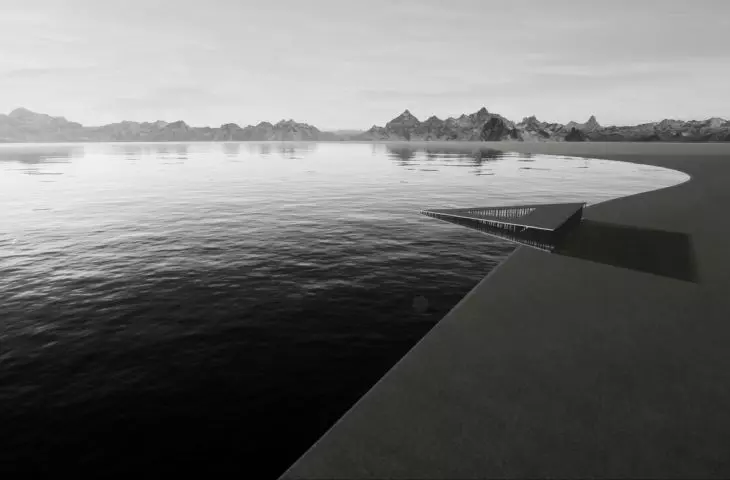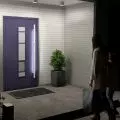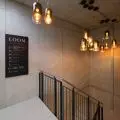{tag:studenci}, a student at the Magdalena Abakanowicz University of Art also participated in the second edition of the Buildner platform's „Museum of Emotions” competition. Her object connecting land and water and blurring the boundaries between them was made under the direction of Hugon Kowalski. The Polish proposal won the appreciation of the jury, which shortlisted it for the competition.
The goal of the competition was to design a museum consisting of two rooms representing opposite emotions—positive and negative. Participants were free to choose the location of the design, the construction or the selection of individual feelings. The competition regulations provided for freedom in the choice of emotions and the location of the building.
High and narrow windows correspond with the openwork walls of the corridors running around the water surface
© Michalina Grzyb
The functional program was not strictly defined, limited to including an exhibition hall in the design. One of the few restrictions placed on the participants was the ban on the use of words in the presentation. In the words of Michalina Grzyb—the „transmission” of emotions was to be done through visual means.
You can read about the composition of the international jury and the awards in the article on the second shortlisted entry from Poland by Natalia Suchy of the Silesian University of Technology.
The Museum of Emotions has a distinctive shape
© Michalina Grzyb
dialogue of land and water
Although the competition challenge was to present only a visualization, we asked Michalina Grzyb to explain her concept. The author chose as the form of the museum an object with a triangular base, one of whose vertices is submerged in the water of the lake.
axsonometry of the museum
© Michalina Grzyb
In my design I aimed to develop a strong form—standing out against the surrounding nature. The lump was to stand out in space, while the building plan suggested a dialogue between land and water. This is done through the arrangement of the projection, in which the base of the triangle is on land and one of its vertices is already in the water. The non-obvious ground on which the museum sits was meant to refer to the variability of feeling extreme emotions. On land we can feel safe thanks to the ground beneath our feet, while in the water we are subjected to a dangerous element, the UAP student explains.
The roof of the museum lowers toward the lake
© Michalina Grzyb
closeness to nature
Nature is associated by the designer with wildness and is represented in the design by the openness of the museum's body. The atrium, around which a covered corridor runs, creates an open part that allows museum visitors to be in constant contact with nature. On the other hand, the canopy that limits the space on the land side and the exhibition rooms symbolize shelter and a sense of security. The scale of the building changes with the slope of the roof, which, connecting the museum's two spaces (open and closed), runs towards the lake, creating the impression of melding with the surface of the water.
The atrium, around which a covered corridor runs, forms the open part
© Michalina Grzyb
interacting with the building
From the land side, the mass of the museum is enclosed by a stone wall, and light reaches its interior through the glazing used on the lake side. The tall and narrow windows correspond with the openwork walls of the corridors that run around the surface of the water. Thanks to glass balustrades, the view of the water is unobstructed. Depending on the position of the sun, a play of light and shadow takes place inside the corridors, creating diagonal lines.
Depending on the position of the sun, a play of light and shadow takes place inside the corridors, creating diagonal lines
© Michalina Grzyb
To enter the building, one must find one of the two corridors hidden in the corners of the museum in the high and monumental façade. Then, wandering through it, visitors reach an enclosed exhibition hall, accessible only from inside the building. Such a procedure, as the author explains, forces visitors to interact with the project.
The interior of the museum—a play of light and shadow
© Michalina Grzyb
The museum is aimed at any person wishing to get away from the fully urbanized urban space to experience a water-land narrative. The unusual design situation related to the lack of restrictions and the possibility to let go of one's imagination was an excellent lesson on the possibility of creating ideas, the author concludes.
Read also about the work of Maja Klawitter from Wroclaw University of Technology entitled Museum of Emotions. The influence of architecture on the control of a person's emotional state, which was made as part of the first edition of the „Museum of emotions” competition.




































